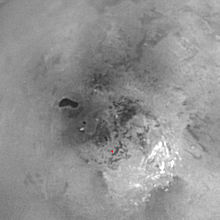Ontario Lacus
Ontario Lacus is a methane/ethane lake near the south pole of Saturn's moon Titan. As a liquid hydrocarbon lake, Ontario Lacus was confirmed by infrared observations of the Cassini spacecraft on 31 July 2008 in the journal Nature. With an area of about 15,000 km², Ontario Lacus is roughly the size of Schleswig-Holstein or Styria, making it slightly smaller than its terrestrial namesake, Lake Ontario in North America.
On January 12, 2010, the Cassinisonde took a higher resolution radar scan of Ontario Lacus, which revealed numerous notable characteristics. The northern shore is characterized by hills approximately 1 km high as well as flooded river valleys. A straight wave-formed shoreline, similar to that of southwestern Lake Michigan, can be observed in the northeastern area. Lines running parallel to the present shoreline may have been formed over long periods of time by low waves, which in turn are probably due to westerly or southwesterly winds. The southeastern shore shows a rounded bay projecting far into the lake.
The central part of the western coast has the first observed and well-developed river delta on Titan. Similar to the Rhone delta in the French Camargue, judging from its morphology, it is a wave-dominated delta where liquid hydrocarbons coming from higher elevations have changed their river channel on their way to the lake, creating at least two peninsulas. Other examples of such channel changes or wave-dominated deltas can be found on Earth at the southern end of Lake Albert in Africa between Uganda and the Democratic Republic of Congo, and as remnants of the former inland sea of Mega-Chad in Chad.
Compared to terrestrial waters of similar extent, Ontario Lacus appears to be remarkably shallow and smooth. Radar scans in July 2009 and January 2010 indicated an average depth of only 0.4 to 3.2 m with a maximum depth of 2.9 to 7.4 m. This would result in an estimated volume of only 7 to 50 km³, less than one-thirtieth of Earth's Lake Ontario. Any waves present on Ontario Lacus at the times of measurement are also no more than 1 mm high, indicating either a complete absence of wind, and/or a viscous, i.e. thick, composition of the liquid hydrocarbons in the lake.
According to the latest research, the fluid level of the Ontario Lacus, as in the Etosha Pan, should change with the level of the fluid present in the soil.

Radar scanning of Ontario Lacus by the Cassini probe on January 12, 2010.

Infrared image of Titan's south pole. Ontario Lacus can be seen left of center as a dark area.
See also
- Methane: Methane on Titan
- Titanium: liquid methane
Search within the encyclopedia